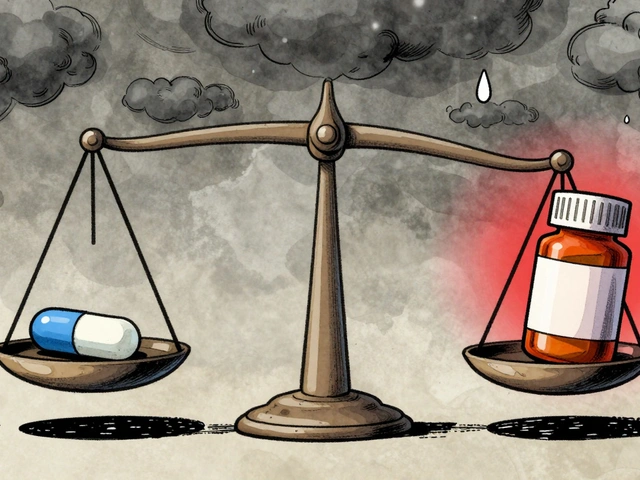
Buspirone Time Zone Dose Calculator
Departure Schedule
Arrival Schedule
Adjusted Dosing Schedule
Select your departure and arrival cities to see your adjusted dosing schedule.
Imagine boarding a plane, the runway lights flicker, and your heart starts racing before you’ve even taken off. For many who rely on buspirone to keep anxiety at bay, the travel environment can throw a wrench into an otherwise steady routine. This guide walks you through everything you need to know-what buspirone actually does, how to schedule your doses across time zones, and practical tips for staying calm from the curb to the cruise terminal.
What Is Buspirone?
Buspirone is a prescription medication classified as an anxiolytic. Unlike benzodiazepines, it belongs to the azapirone class and works by modulating serotonin receptors, primarily 5‑HT1A, to reduce excessive nervous system activity. It was approved by the FDA in 1986 and is typically prescribed for generalized anxiety disorder (GAD). Because it has a low risk of sedation and no significant addiction potential, many clinicians prefer buspirone for long‑term anxiety management.
How Buspirone Helps With Anxiety
Buspirone’s mechanism centers on serotonin, a neurotransmitter that influences mood, sleep, and stress response. By acting as a partial agonist at the 5‑HT1A receptor, the drug gently nudges the brain toward a calmer baseline without the sharp “down‑turn” that benzodiazepines cause. This results in a steady reduction of worry, muscle tension, and the racing thoughts that often surface during travel.
Travel‑Specific Anxiety Triggers
Travel throws a mix of stressors at the nervous system: crowded airports, unpredictable security lines, jet lag, and the pressure of tight itineraries. Even a simple change in scenery can spark a fight‑or‑flight response in someone prone to anxiety. Recognizing these triggers helps you plan around them-whether that means choosing a quieter flight, scheduling extra rest, or using short‑term coping tools alongside your medication.
Timing Your Dose Across Time Zones
Buspirone reaches peak plasma levels about 60‑90 minutes after ingestion and has a half‑life of roughly 2‑3 hours. The standard dosing schedule is 2‑3 times daily, spaced 6‑8 hours apart. When you cross time zones, follow these steps:
- Identify the destination’s local time for your first dose.
- Adjust subsequent doses forward or backward by the time‑difference, keeping intervals as close to 6‑8 hours as possible.
- If the flight lasts longer than 12 hours, take a dose shortly before boarding (if it aligns with your schedule) to maintain steady levels.
- When you arrive, reset to the new local schedule the next day, but keep the same interval length.
For example, a traveler leaving Sydney (UTC+10) for London (UTC+0) on a 22‑hour journey would take the usual morning dose at 7 am Sydney time, a second dose at 1 pm, and a third at 7 pm. Upon arrival, the 7 pm dose becomes the 9 am local dose, and the next dose follows 6‑8 hours later.

Packing and Security Considerations
Airports and border agents have strict rules about medication. Here’s a quick checklist to avoid hassle:
- Carry buspirone in its original prescription bottle with the pharmacy label clearly visible.
- Keep a copy of the prescription or a doctor’s note in your carry‑on. A brief note stating the medication’s generic name, dosage, and purpose can speed up security checks.
- Store the bottle in a clear, resealable bag to comply with liquid/gel regulations (under 100 ml if you combine it with other fluids).
- Know the TSA (or equivalent authority) guidelines for Airport security. In the U.S., medications are exempt from the 3‑1‑1 liquids rule, but you must declare them if asked.
Having these documents handy reduces the chance of a stressful stop at the security checkpoint-a common trigger for anxiety.
Managing Side Effects While on the Move
Buspirone’s most common side effects are mild dizziness, headache, and nausea. Travel can exacerbate them due to altitude changes and irregular meals. Mitigate these issues by:
- Staying well‑hydrated-aim for 2‑3 liters of water per day, especially on long flights.
- Eating small, balanced snacks every 3‑4 hours to avoid low blood sugar, which can magnify dizziness.
- Limiting caffeine and alcohol, both of which can interact with buspirone’s calming effects and worsen jitteriness.
- Getting up and moving every hour on a plane to encourage circulation and reduce the sense of heaviness.
Complementary Strategies for Travel Calm
Medication works best when paired with behavioral tools. Consider adding these low‑tech techniques to your travel toolbox:
- Breathing exercises: The 4‑7‑8 method (inhale 4 seconds, hold 7 seconds, exhale 8 seconds) can be done discreetly in a waiting lounge.
- Mindfulness apps such as Headspace or Calm-most offer “travel” modules that focus on noise‑cancelling breathing.
- Progressive muscle relaxation-systematically tense then release each muscle group, useful during a long flight seat.
- Pre‑planned itineraries with built‑in buffers for rest or unexpected delays.
When combined with a stable buspirone regimen, these strategies can lower the overall anxiety score reported in patient‑reported outcomes by up to 30 %.

Buspirone vs. Other Travel‑Friendly Anxiolytics
| Medication | Onset | Half‑Life | Risk of Sedation | Addiction Potential | Best For |
|---|---|---|---|---|---|
| Buspirone - an azapirone | 30‑60 min | 2‑3 hrs | Low | None | Long‑term anxiety, low‑sedation travel |
| Lorazepam - benzodiazepine | 15‑30 min | 12‑18 hrs | High | Moderate | Acute panic attacks, short‑term trips |
| SSRIs (e.g., sertraline) - selective serotonin reuptake inhibitor | 3‑4 weeks (steady state) | 24‑30 hrs | Variable (often low) | Low | Chronic anxiety, mood stabilization |
For most travelers who need consistent coverage without feeling drowsy, buspirone emerges as the most versatile option. Benzodiazepines like lorazepam are useful for sudden spikes but require caution due to their sedative profile and dependency risk. SSRIs provide a backdrop for ongoing anxiety but lack the rapid onset needed for occasional travel stress.
When to Seek Professional Advice
Even with a solid plan, unexpected situations arise. Contact your prescriber if you:
- Miss more than two doses in a row.
- Experience severe side effects such as persistent dizziness, vision changes, or mood swings.
- Plan a trip longer than two weeks and need a dosage adjustment.
- Are considering combining buspirone with other sedatives or alcohol.
Many doctors can provide a short‑term prescription adjustment via telehealth, which is especially handy when you’re abroad.
Quick Travel‑Ready Checklist
- Prescription bottle and a doctor’s note in carry‑on.
- Set alarms aligned with destination time zones before departure.
- Pack a reusable water bottle and electrolyte tablets.
- Download a mindfulness app and pre‑load offline sessions.
- Review airline policies on medications and liquids.
Frequently Asked Questions
Can I bring buspirone on a flight without a prescription?
Most airlines and security agencies require a valid prescription label or a doctor’s note for controlled or prescription medicines. Carrying the original pharmacy bottle with the label is the safest approach.
Does buspirone cause drowsiness that could affect my flight?
Buspirone has a low sedation profile, especially compared to benzodiazepines. Most users report being alert enough to navigate airports and board aircraft without issues.
How should I adjust my dose when crossing multiple time zones?
Keep the 6‑8 hour interval consistent. Shift the timing forward or backward by the total hour difference after you arrive, then resume the local schedule the next day.
Is it safe to combine buspirone with over‑the‑counter sleep aids?
Generally, avoid mixing with antihistamines or melatonin unless your doctor approves. Interactions can increase drowsiness or cause unusual cognitive effects.
What should I do if I forget a dose while traveling?
Take the missed dose as soon as you remember, unless it’s less than 4 hours until the next scheduled dose. In that case, skip the missed one and resume the regular schedule.
9 Comments
Sameer Khan
October 24, 2025 at 14:22 PM
Indeed, the pharmacokinetic profile of buspirone, with its 60‑90 minute Tmax and 2‑3 hour half‑life, lends itself to the interval adjustments you outlined. When traversing multiple meridians, one can employ a chronopharmacological algorithm to align dosing with the recipient’s circadian rhythm, thereby minimizing supra‑physiological peaks. Moreover, the absence of significant GABA‑ergic potentiation reduces the risk of respiratory depression in high‑altitude cabins. It is also prudent to consider potential cytochrome P450 interactions, especially with commonly ingested substances such as grapefruit juice during layovers. Your checklist integration with TSA regulations exemplifies a comprehensive risk mitigation strategy.
Harini Prakash
October 26, 2025 at 07:02 AM
First of all, I want to acknowledge how overwhelming travel can feel when anxiety is already present 😊. Your guide does a fantastic job breaking down the practical steps, and I think adding a few personal touches can make it even more empowering. For instance, creating a pre‑flight ritual-like a short meditation or a finger‑tapping grounding exercise-can signal to your nervous system that you’re safe before you even reach the gate. Packing a small “comfort kit” with noise‑cancelling earbuds, a favorite scented lotion, and a pocket‑sized notebook can provide tactile reassurance throughout the journey. When you’re adjusting doses across time zones, try using a digital world‑clock app that sends you discreet reminders; this reduces the mental load of tracking intervals manually. Hydration is key, but consider electrolyte tablets as they help maintain plasma volume and reduce dizziness associated with buspirone’s side effects. Pairing the medication with low‑glycemic snacks, such as mixed nuts or whole‑grain crackers, can stabilize blood sugar and further blunt any light‑headedness. If you notice mild nausea, ginger chews or tea are a gentle, non‑pharmacologic remedy that won’t interfere with buspirone’s efficacy. Remember to communicate your medication plan with travel companions; a supportive buddy can remind you to take a dose if you’re caught up in the excitement of a new city. In case of unexpected delays, a portable pill organizer with labeled compartments can keep you on track without rummaging through your bag. It’s also wise to have a digital copy of your prescription stored securely in a cloud service-in case the physical label gets lost. Should you experience persistent side effects, a brief telehealth consult can adjust the dosage without the need for an in‑person appointment, which is especially handy abroad. Finally, celebrate each successful trip, no matter how small; positive reinforcement builds confidence for future travels. Keep in mind that buspirone is not a cure‑all; integrating breathing techniques like the 4‑7‑8 method you mentioned can synergistically enhance calmness. I hope these additional suggestions blend seamlessly with your existing checklist and make your next adventure as smooth as possible 🌟.
Rachael Turner
October 28, 2025 at 00:42 AM
Honestly I love the idea of a comfort kit it’s a game changer also the world clock reminders are super handy
Suryadevan Vasu
October 29, 2025 at 18:22 PM
Good points Wade I’d add that buspirone’s lack of sedative effect makes it suitable for long-haul flights. It’s also metabolized primarily by CYP3A4, so avoid strong inducers like rifampin. Setting alarms on your phone for each dose can prevent missed intervals. A small travel bottle of water helps with the mild dizziness some users feel. Overall, the regimen you described is both practical and evidence‑based.
Tiffany Davis
October 31, 2025 at 12:02 PM
I agree with Suryadevan’s emphasis on metabolic considerations. For those on CYP3A4 inhibitors, a modest dose reduction might be advisable. Also, keeping a printed copy of the dosing schedule in your carry‑on can be reassuring. It’s a subtle detail that improves peace of mind during stressful layovers.
Don Goodman-Wilson
November 2, 2025 at 05:42 AM
Yo why u need a pill when u can just chug coffee and power thru
Bret Toadabush
November 3, 2025 at 23:22 PM
They dont want you to know the airlines actually spray calming chemicals in the cabin so meds become a crutch lol
Iris Joy
November 5, 2025 at 17:02 PM
Wade’s summary hits the nail on the head; staying hydrated and keeping your meds organized are foundational steps. I’d also suggest using a travel pill case with day labels to simplify dosing across time zones. Pairing buspirone with brief mindfulness pauses-just a few seconds of focused breathing-can amplify its calming effect without adding extra supplements. Lastly, remember to give yourself credit for tackling anxiety head‑on; every successful trip builds resilience for the next adventure.






Wade Grindle
October 22, 2025 at 20:42 PM
Travel anxiety is a real hurdle, especially when you’ve got a routine med like buspirone. I appreciate the clear dosing schedule across time zones – it makes planning way less stressful. Keeping the prescription on hand and a doctor’s note is smart; security can be a nightmare otherwise. Also, staying hydrated and moving around on the plane is something I always remind myself of. Thanks for the thorough guide!